child restraint Hyundai Grandeur 2003 Owner's Manual
[x] Cancel search | Manufacturer: HYUNDAI, Model Year: 2003, Model line: Grandeur, Model: Hyundai Grandeur 2003Pages: 235, PDF Size: 14.25 MB
Page 15 of 235

1. FEATURES OF YOUR HYUNDAIFuel Recommendations .................................................................. 1-2
Breaking In Your New Hyundai ...................................................... 1-3
Keys (Immobilizer System) ...................................................... 1-3, 1-4
Door Locks (Theft-Alarm System) ........................................... 1-6, 1-8
Power Windows ............................................................................ 1-10
Seat (Power Seat) ............................................................... 1-11, 1-14
I.M.S (Integrated Memory System) ............................................... 1-16
Seat Belt ....................................................................................... 1-19
Child Restraint System ................................................................. 1-24
Supplemental Restraint (AIRBAG) System .................................. 1-32
Instrument Cluster and Indicator Lights ........................................ 1-40
Warning Light and Indicator ......................................................... 1-42
Multi-function Light Switch ............................................................ 1-49
Windshield Wiper/Washer Switch ................................................. 1-51
Trip Computer ............................................................................... 1-54
Sunroof ......................................................................................... 1-58
Mirror ............................................................................................. 1-63
Hood Release ............................................................................... 1-69
Cruise Control ............................................................................... 1-74
Audio Remote Control Switch ....................................................... 1-76
Heating and Cooling Control ........................................................ 1-78
Stereo Sound System ................................................................... 1-93
Audio System ................................................................................ 1-95
Antenna ...................................................................................... 1-117
1
Page 33 of 235

FEATURES OF YOUR HYUNDAI 1- 19
B150D01A-AAT Pregnant Women The use of a seat belt is recommended for pregnant women to lessen thechance of injury in an accident. When a seat belt is used, the lap belt portion should be placed as low and snugly aspossible on the hips, not across the abdomen. For specific recommenda- tions, consult a physician.
B150C02A-AAT Larger Children Children who are too large for child restraint systems should always oc-cupy the rear seat and use the avail- able lap/shoulder belts. The lap por- tion should be fastened snug on thehips and as low as possible. Check belt fit periodically. A child's squirming could put the belt out of position. Chil-dren are afforded the most safety in the event of an accident when they are restrained by a proper restraint sys-tem in the rear seat. If a larger child (over age 13) must be seated in the front seat, the child should be securelyrestrained by the available lap/shoul- der belt and the seat should be placed in the rear most position. Children un-der the age of 13 should be restrained securely in the rear seat. NEVER place a child under the age of 13 in the frontseat. NEVER place a rear facing child seat in the front seat of a vehicle.
B150F01A-AAT One Person Per Belt Two people (including children) should never attempt to use a single seat belt. This could increase the severity of injuries in case of an accident.
B150E01A-AAT Injured Person A seat belt should be used when an injured person is being transported. When this is necessary, you shouldconsult a physician for recommenda- tions.
B150B01Y-GAT Infant or Small Child Some countries require the use of child restraint systems for infants andsmall children. Whether this is required by law or not, it is strongly recom- mended that a child restraint seat orinfant restraint system be used for infants or small children weighing less than 18 kilograms (40 pounds). NOTE: Small children are best protected in an accident when properly re- strained by a child restraint sys-tem.
B150A02A-GAT SEAT BELT PRECAUTIONS All occupants of the vehicle should wear their seat belts at all times. In-deed, your province's laws may re- quire that some or all occupants of the vehicle use seat belts.The possibility of injury or the severity of injury in an accident will be de- creased if this elementary safety pre-caution is observed. In addition, the following recommendations are made:
Page 38 of 235

1- 24 FEATURES OF YOUR HYUNDAI
o Children who are too large to be
in a child restraint should sit in the rear seat and be restrained with the available lap/shoulderbelts. Never allow children to ride in the front passenger seat.
o Always make sure that the shoul- der belt portion of the outboardlap/shoulder belt is positionedmidway over the shoulder, never across the neck. Moving the child closer to the center of the vehiclemay help provide a good shoul- der belt fit. The lap belt portion of the lap/shoulder belt or the cen-ter seat lap belt must always be positioned as low as possible on the child's hips and as snug aspossible.
o If the seat belt will not properly fit
the child, Hyundai recommendsthe use of an approved booster seat in the rear seat in order to raise the child's seating heightso that the seat belt will properly fit the child.
WARNING:
o A child restraint system must be placed in the rear seat. Never install a child or infant seat on the front passenger's seat. Should an accident occur andcause the passenger side airbag to deploy, it could severely in- jure or kill an infant or child seatedin an infant or child seat. Thus, only use a child restraint in the rear seat of your vehicle.
o Since a safety belt or child re- straint system can become veryhot if it is left in a closed vehicle,be sure to check the seat cover and buckles before placing a child there.
o When the child restraint system is not in use, store it in the trunkor fasten it with a safety belt sothat it will not be thrown forward in the case of a sudden stop or an accident.
!
B230A03A-GAT CHILD RESTRAINT SYSTEM (If installed) Children riding in the car should sit in the rear seat and must always be restrained to minimize the risk of injuryin an accident, sudden stop or sudden maneuver. According to accident sta- tistics, children are safer when prop-erly restrained in the rear seats than in the front seat. Larger children not in a child restraint should use one of theseat belts provided. You are required by law to use safety restraints for children. If small childrenride in your vehicle you must put them in a child restraint system (safety seat). Children could be injured or killed in acrash if their restraints are not properly secured. For small children and ba- bies, a child seat or infant seat must beused. Before buying a particular child restraint system, make sure it fits your car seat and seat belts, and fits yourchild. Follow all the instructions pro- vided by the manufacturer when in- stalling the child restraint system.
Page 39 of 235
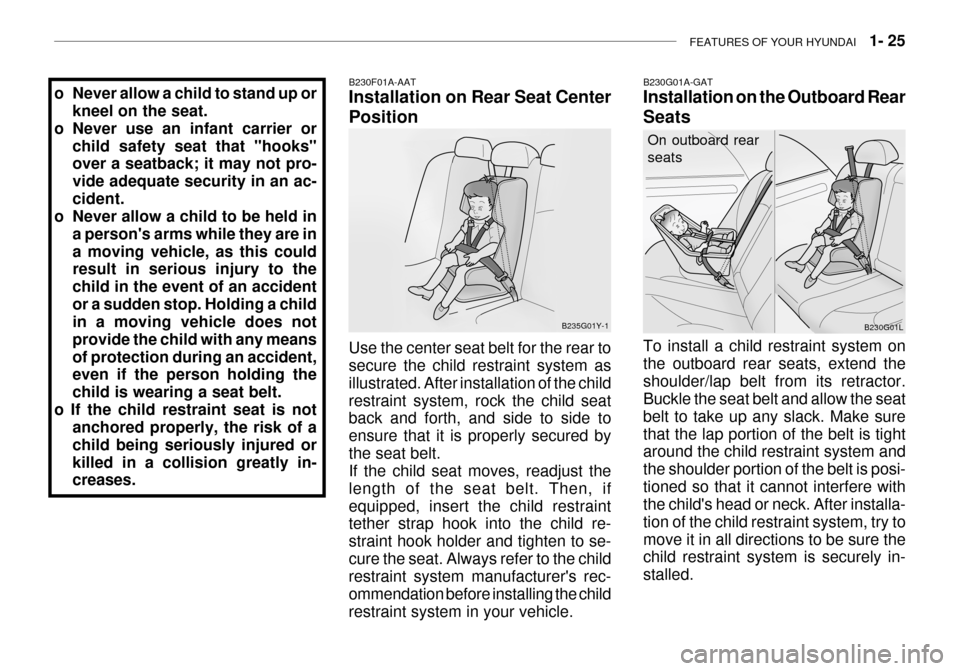
FEATURES OF YOUR HYUNDAI 1- 25
o Never allow a child to stand up or
kneel on the seat.
o Never use an infant carrier or child safety seat that "hooks" over a seatback; it may not pro- vide adequate security in an ac-cident.
o Never allow a child to be held in
a person's arms while they are ina moving vehicle, as this could result in serious injury to the child in the event of an accidentor a sudden stop. Holding a child in a moving vehicle does not provide the child with any meansof protection during an accident, even if the person holding the child is wearing a seat belt.
o If the child restraint seat is not anchored properly, the risk of achild being seriously injured orkilled in a collision greatly in- creases.B230F01A-AAT Installation on Rear Seat Center Position
B235G01Y-1
Use the center seat belt for the rear to secure the child restraint system as illustrated. After installation of the childrestraint system, rock the child seat back and forth, and side to side to ensure that it is properly secured bythe seat belt. If the child seat moves, readjust the length of the seat belt. Then, ifequipped, insert the child restraint tether strap hook into the child re- straint hook holder and tighten to se-cure the seat. Always refer to the child restraint system manufacturer's rec- ommendation before installing the childrestraint system in your vehicle.
On outboard rear seats
B230G01A-GATInstallation on the Outboard Rear Seats To install a child restraint system on the outboard rear seats, extend theshoulder/lap belt from its retractor. Buckle the seat belt and allow the seat belt to take up any slack. Make surethat the lap portion of the belt is tight around the child restraint system and the shoulder portion of the belt is posi-tioned so that it cannot interfere with the child's head or neck. After installa- tion of the child restraint system, try tomove it in all directions to be sure the child restraint system is securely in- stalled. B230G01L
Page 40 of 235
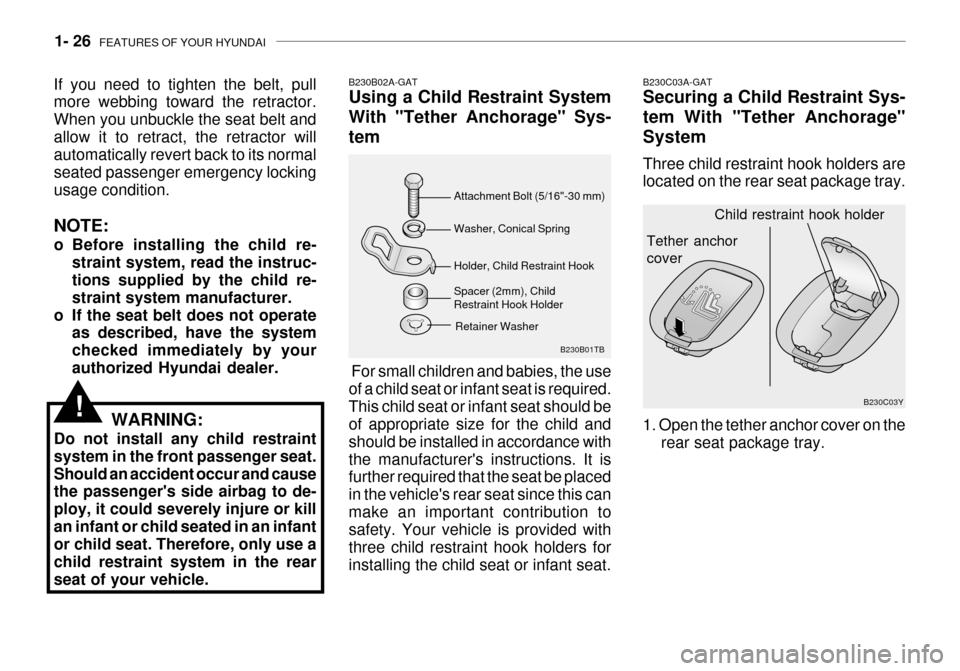
1- 26 FEATURES OF YOUR HYUNDAI
Tether anchor cover
B230C03Y
Child restraint hook holder
Spacer (2mm), Child Restraint Hook HolderB230B01TB
Attachment Bolt (5/16"-30 mm) Washer, Conical Spring Holder, Child Restraint Hook
B230B02A-GAT Using a Child Restraint System With "Tether Anchorage" Sys-tem For small children and babies, the use of a child seat or infant seat is required.This child seat or infant seat should be of appropriate size for the child and should be installed in accordance withthe manufacturer's instructions. It is further required that the seat be placed in the vehicle's rear seat since this canmake an important contribution to safety. Your vehicle is provided with three child restraint hook holders forinstalling the child seat or infant seat. B230C03A-GAT Securing a Child Restraint Sys- tem With "Tether Anchorage"System Three child restraint hook holders are located on the rear seat package tray. 1. Open the tether anchor cover on the
rear seat package tray.
Retainer Washer
If you need to tighten the belt, pull more webbing toward the retractor. When you unbuckle the seat belt andallow it to retract, the retractor will automatically revert back to its normal seated passenger emergency lockingusage condition. NOTE:
o Before installing the child re-
straint system, read the instruc- tions supplied by the child re- straint system manufacturer.
o If the seat belt does not operate as described, have the systemchecked immediately by yourauthorized Hyundai dealer.
WARNING:
Do not install any child restraintsystem in the front passenger seat.Should an accident occur and cause the passenger's side airbag to de- ploy, it could severely injure or killan infant or child seated in an infant or child seat. Therefore, only use a child restraint system in the rearseat of your vehicle.
!
Page 41 of 235
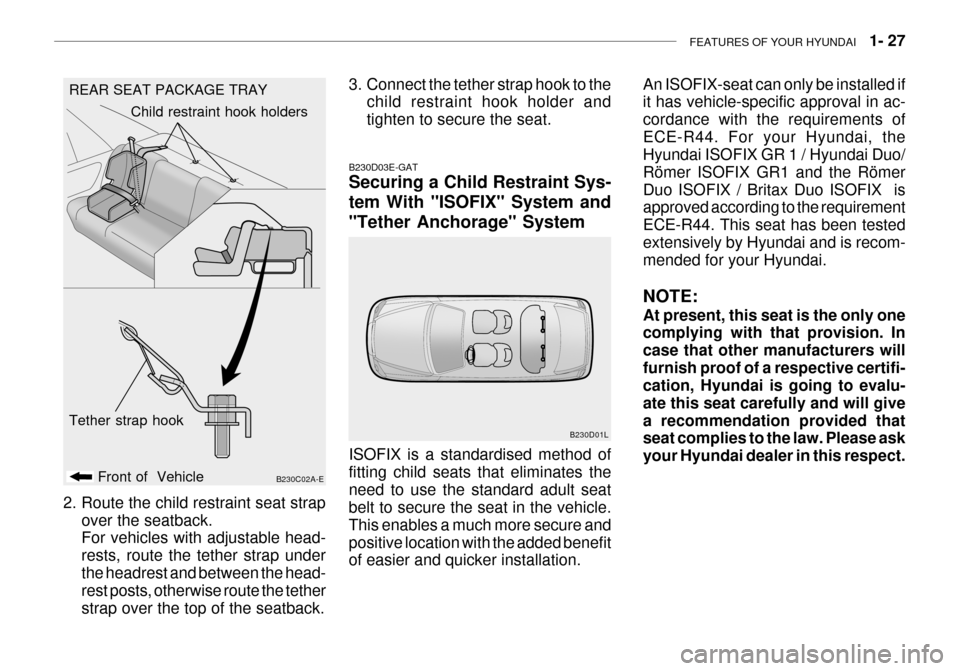
FEATURES OF YOUR HYUNDAI 1- 27
REAR SEAT PACKAGE TRAY
B230C02A-E
Front of Vehicle Child restraint hook holders
Tether strap hook
B230D03E-GAT Securing a Child Restraint Sys- tem With "ISOFIX" System and"Tether Anchorage" System
2. Route the child restraint seat strap over the seatback. For vehicles with adjustable head- rests, route the tether strap underthe headrest and between the head- rest posts, otherwise route the tether strap over the top of the seatback. An ISOFIX-seat can only be installed if it has vehicle-specific approval in ac- cordance with the requirements ofECE-R44. For your Hyundai, the Hyundai ISOFIX GR 1 / Hyundai Duo/ Römer ISOFIX GR1 and the RömerDuo ISOFIX / Britax Duo ISOFIX is approved according to the requirement ECE-R44. This seat has been testedextensively by Hyundai and is recom- mended for your Hyundai. NOTE: At present, this seat is the only one complying with that provision. In case that other manufacturers willfurnish proof of a respective certifi- cation, Hyundai is going to evalu- ate this seat carefully and will givea recommendation provided that seat complies to the law. Please ask your Hyundai dealer in this respect.
3. Connect the tether strap hook to the
child restraint hook holder andtighten to secure the seat.
ISOFIX is a standardised method offitting child seats that eliminates theneed to use the standard adult seat belt to secure the seat in the vehicle. This enables a much more secure andpositive location with the added benefit of easier and quicker installation.
B230D01L
Page 42 of 235
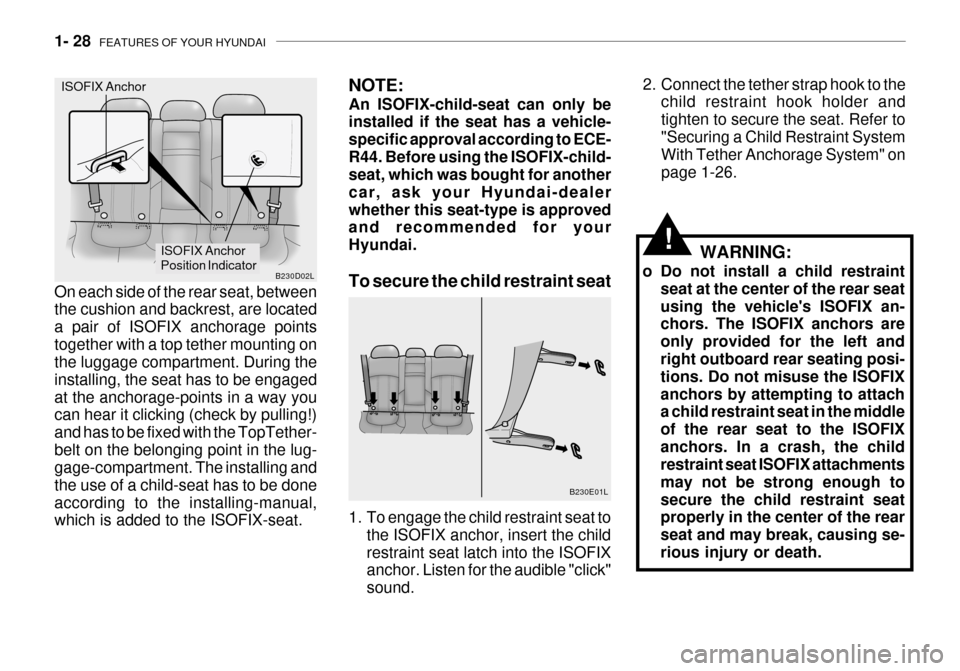
1- 28 FEATURES OF YOUR HYUNDAI
!WARNING:
o Do not install a child restraint seat at the center of the rear seat using the vehicle's ISOFIX an- chors. The ISOFIX anchors are only provided for the left and right outboard rear seating posi- tions. Do not misuse the ISOFIXanchors by attempting to attach a child restraint seat in the middle of the rear seat to the ISOFIXanchors. In a crash, the child restraint seat ISOFIX attachments may not be strong enough tosecure the child restraint seat properly in the center of the rear seat and may break, causing se-rious injury or death.
NOTE: An ISOFIX-child-seat can only be installed if the seat has a vehicle- specific approval according to ECE-R44. Before using the ISOFIX-child- seat, which was bought for another car, ask your Hyundai-dealerwhether this seat-type is approved and recommended for your Hyundai. To secure the child restraint seat
B230E01L
1. To engage the child restraint seat to the ISOFIX anchor, insert the child restraint seat latch into the ISOFIX anchor. Listen for the audible "click" sound. 2. Connect the tether strap hook to the
child restraint hook holder andtighten to secure the seat. Refer to"Securing a Child Restraint System With Tether Anchorage System" on page 1-26.
ISOFIX Anchor
B230D02L
ISOFIX Anchor Position Indicator
On each side of the rear seat, between the cushion and backrest, are located a pair of ISOFIX anchorage pointstogether with a top tether mounting on the luggage compartment. During the installing, the seat has to be engagedat the anchorage-points in a way you can hear it clicking (check by pulling!) and has to be fixed with the TopTether-belt on the belonging point in the lug- gage-compartment. The installing and the use of a child-seat has to be doneaccording to the installing-manual, which is added to the ISOFIX-seat.
Page 43 of 235

FEATURES OF YOUR HYUNDAI 1- 29
B180B01HP-GAT Pre-tensioner Seat Belt Your Hyundai vehicle is equipped with driver's and front passenger's pre- tensioner seat belts. The purpose of the pre-tensioner is to make sure thatthe seat belts fit tightly against the occupant's body in certain frontal col- lisions.The pre-tensioner seat belts can be activated alone or, where the frontal collision is severe enough, togetherwith the airbags.
Rear
Center
Age Group Seating Position
UU
F
XUU F
X U, L1 UF XU FUF
Rear
Outboard
Front
Passenger
0 : Up to 10 kg (0 ~ 9 months)0+ : Up to 13 kg(0 ~ 2 years)I : 9kg to 18kg(9 months ~ 4years)II & III : 15kg to36kg (4 ~ 12 years) X
B230H01L-GAT Child Seat Restraint Suitability For Seat Position Use child safety seats that have been officially approved and are appropriate for your children. When using the childsafety seats, refer to the following table.
U :Suitable for "universal" category
restraints approved for use in this mass group
UF :Suitable for forward-facing "uni-
versal" category restraints ap-proved for use in this mass group
o Do not mount more than one
child restraint to a child restraint lower anchorage point. The im- proper increased load may causethe anchorage points or tether anchor to break, causing serious injury or death.
o Attach the ISOFIX or ISOFIX-com- patible child restraint seat onlyto the appropriate locationsshown in the illustration.
o Always follow the installation and
use instructions provided by themanufacturer of the child re- straint. L1: Suitable for "Römer ISOFIX GR1"
approved for use in this mass group
(Approval No: E1 R44-03301133)
X : Seat position not suitable for chil- dren in this mass group
Page 47 of 235

FEATURES OF YOUR HYUNDAI 1- 33
o For maximum safety protection
in all types of crashes, all occu- pants including the driver should always wear their seat belts whether or not an airbag is alsoprovided at their seating posi- tion to minimize the risk of se- vere injury or death in the eventof a crash. Do not sit or lean unnecessarily close to the airbag while the vehicle is in motion.
o The SRS airbag system must de- ploy very rapidly to provide pro-tection in a crash. If an occupantis out of position because of not wearing a seat belt, the airbag may forcefully contact the occu-pant causing serious or fatal in- juries.o Front airbags are not intended to
deploy in side-impact, rear-im- pact or rollover crashes. In addi- tion, airbags will not deploy in frontal crashes below the deploy-ment threshold speed.
o The driver should sit back as far
as possible while still maintain-ing control of the vehicle. If you are sitting too close to the airbag, it can cause death or seriousinjury when it inflates.
o No objects should be placed over
or near the airbag modules onthe steering wheel, instrument panel, and the front passenger's panel above the glove box,because any such object could cause harm if the vehicle is in a crash severe enough to causethe airbags to deploy.
o If the airbags deploy, they must
be replaced by an authorizedHyundai dealer. o Do not tamper with or discon-
nect SRS wiring, or other com-ponents of the SRS system. Do- ing so could result in injury, due to accidental firing of the airbagsor by rendering the SRS inopera- tive.
o Do not install a child restraint system in the front passengerseat position. A child restraint system must never be placed inthe front seat. The infant or child could be severely injured or killed by an airbag deployment in caseof an accident.
o Do not allow children to ride in
the front passenger seat. If olderchildren (teenagers and older) must ride in the front seat, make sure they are always properlybelted and that the seat is moved back as far as possible.
Page 50 of 235
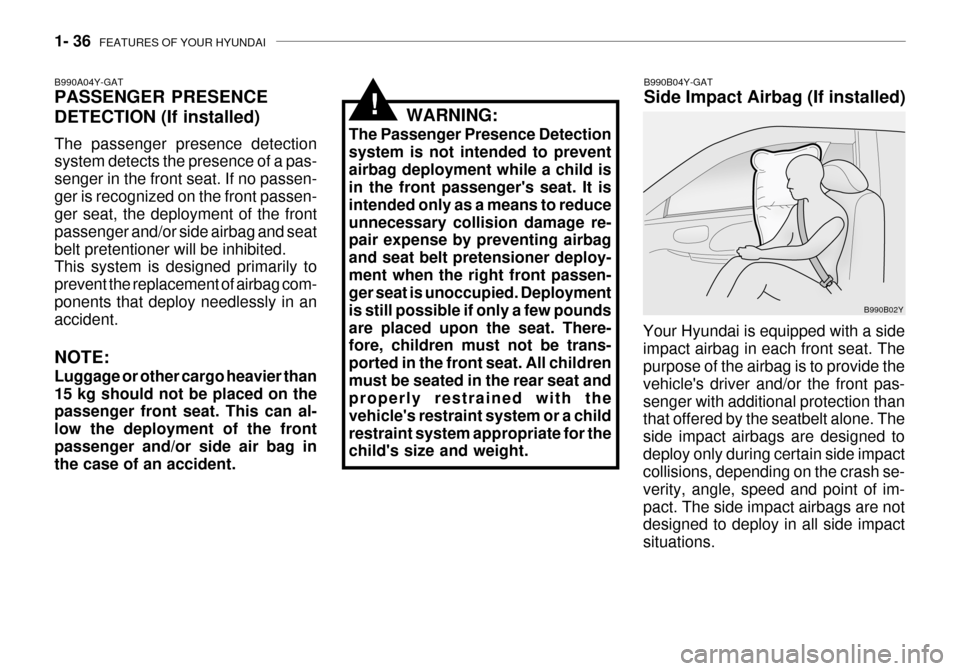
1- 36 FEATURES OF YOUR HYUNDAI
B990B04Y-GAT Side Impact Airbag (If installed)
Your Hyundai is equipped with a side impact airbag in each front seat. The purpose of the airbag is to provide the vehicle's driver and/or the front pas-senger with additional protection than that offered by the seatbelt alone. The side impact airbags are designed todeploy only during certain side impact collisions, depending on the crash se- verity, angle, speed and point of im-pact. The side impact airbags are not designed to deploy in all side impact situations. B990B02Y
WARNING:
The Passenger Presence Detectionsystem is not intended to preventairbag deployment while a child is in the front passenger's seat. It is intended only as a means to reduceunnecessary collision damage re- pair expense by preventing airbag and seat belt pretensioner deploy-ment when the right front passen- ger seat is unoccupied. Deployment is still possible if only a few poundsare placed upon the seat. There- fore, children must not be trans- ported in the front seat. All childrenmust be seated in the rear seat and properly restrained with the vehicle's restraint system or a childrestraint system appropriate for the child's size and weight.
!
B990A04Y-GAT PASSENGER PRESENCE
DETECTION (If installed) The passenger presence detection system detects the presence of a pas- senger in the front seat. If no passen-ger is recognized on the front passen- ger seat, the deployment of the front passenger and/or side airbag and seatbelt pretentioner will be inhibited. This system is designed primarily to prevent the replacement of airbag com-ponents that deploy needlessly in an accident. NOTE: Luggage or other cargo heavier than 15 kg should not be placed on the passenger front seat. This can al- low the deployment of the frontpassenger and/or side air bag in the case of an accident.